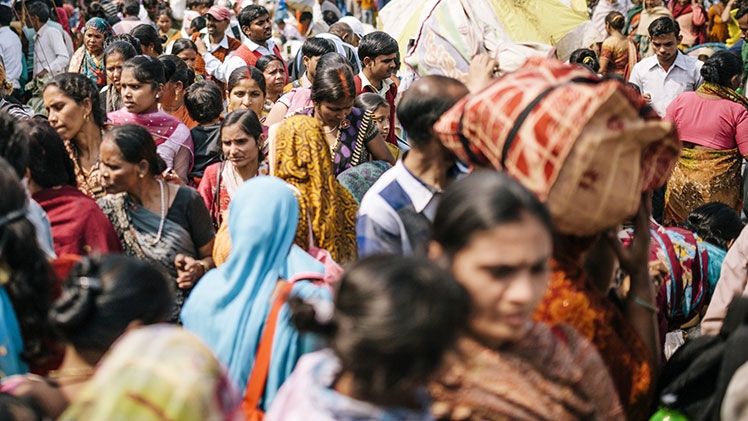India: a lacklustre win for Narendra Modi
- 2024.13.06
- 0
- Download the publication (PDF - 339,39 KB)

Read the article
At the end of a six-week electoral marathon marked by intense heat waves in the north of the country, India’s 650 million voters delivered their verdict: yes to a third term for Narendra Modi, prime minister for the last ten years, but no to the supermajority he was seeking, which would have given him carte blanche to govern as he saw fit. The voter turnout rate was 66%, compared with 67% in 2019.
Neither fraud detected in several states, nor the freezing of the Congress Party’s accounts, nor arrests of opposition figures, nor the campaign’s extreme violence, notably against Muslim communities, nor fake exit polls predicting a huge majority for the BJP (Bharatiya Janata Party), nor the personal involvement of Modi, who took part in over 200 meetings, could change the course of the election.
Even though the opposition, united around the Congress Party under the INDIA banner (Indian National Developmental Inclusive Alliance), did not achieve its goal of preventing Modi from winning a third term, it is set to have won 234 seats, compared with 240 for the BJP, 63 fewer than it previously held. The “saffron wave” expected by Modi, who had been hoping to win between 370 and 400 seats, failed to materialise.
Worse still, the BJP did not even secure an absolute majority (272 seats) and is thus going to have to rely on its allies (53 seats) to govern. The bitterest defeat came in the party’s stronghold of Uttar Pradesh, India’s most populous state lying in the country’s northwest, where the BJP and its allies won just 36 seats, compared with 64 in 2019.
Initial negotiations with two key regional leaders, Nitish Kumar from Bihar and Chandrababu Naidu from Andhra Pradesh, are already underway, but their support is likely to come at a heavy price and does not preclude a degree of instability over the next five years. Ultimately, the Modi camp has emerged much weakened from these elections, which show just how resilient Indian democracy can be, despite the attacks on it these last few years.
A big win for the BJP would have allowed Modi to push through sweeping constitutional change, notably concerning the role of the Hindu religion in Indian society, and further exclude the Muslim community (around 200 million people).
The paradoxes of the Indian economy
Whereas the BJP focused its campaign on community polarisation and the person of Modi, the INDIA alliance decided to hone in on economic issues – a strategy that paid off.
Despite India’s impressive growth figures, its population is still waiting to feel any tangible benefits. In the 2024 tax year (March 2023 to March 2024), GDP increased by 8.2%, a record level that should, according to Modi, be seen as “a foretaste of what’s to come for India”. But specialists in the Indian economy regularly call these numbers into question, saying the authorities have a tendency to overestimate performance.
It should be noted that the Indian economy has still not been able to create enough jobs to meet demand from new entrants into the labour market. Some 813 million Indians still rely on food aid (5 kg of cereal a month per person) to be able to feed themselves and 60% of the population lives on less than $5 a day.
While the official unemployment rate hovers around 7%, the proportion of working-age women in work remains extremely low at 26%, compared with 74% of working-age men. Half the population still derives its sole income from farming, while 42% of young graduates are unemployed. Informality rules, with only one out of every ten Indians having an employment contract and the social safety net that comes with it.
These last few years, the agricultural sector has not been spared by climate change, with harvests hit by heat waves, drought, flooding and invasive pests. While the monsoon accounts for around 80% of annual rainfall, the unpredictability of its extent and timing is undermining the structure of India’s agricultural sector, which mainly relies on small farms averaging only just over 2.5 acres.
Faced with falling yields as well as higher operating costs, particularly as a result of the surge in energy prices since the start of the war in Ukraine (oil accounts for approximately one third of India’s total imports), Indian farmers are locked in a tug of war with the authorities to try to get them to expand the floor price mechanism, which already applies to some cereals, to other agricultural products. Yet this issue, of key importance in a country where only just over 40% of the population lives in urban areas, was not at the centre of the BJP’s campaign. The loss of many seats in the mostly rural state of Uttar Pradesh indicates that voters are mainly worried about the economy rather than Modi’s anti-Muslim crusade.
With inflation tending to exceed the central bank’s target (between 2% and 6%) and food products making up half of the consumer price index, the issue of keeping a lid on prices remains just as central as that of jobs and labour market integration for young people and women.
Labour market weakness is partly a result of decisions by the authorities to focus public investment on relatively non-labour-intensive sectors (mining, energy and services, particularly in new technologies), with the result that added value has risen much faster than employment in some sectors. The industrial sector accounts for only 26% of added value and jobs, compared with 40% and 32% respectively in China. Industry is often key to a country’s development trajectory: as well as being labour-intensive and helping formalise and structure the labour market, it offers a way into international trade.
India still has a long way to go on that score: even though it still accounts for less than 2% of total global exports, the import tariffs it imposes remain well above those in force in other Asian economies that are its direct competitors in areas like assembly, electronic devices and goods related to climate transition. The upshot is that, while India may appear to be a central element in a strategy of diversifying production sites away from dependence on China, investors are put off by the large number of tariff and non-tariff barriers to entry and see it as a market that’s hard to break into.
Lastly, as a result of the previous points and the uneven distribution of recent growth gains, inequality has exploded in India under Modi, who has strongly favoured a few major families, chief among them the Adani family, implicated in a huge corruption and fraud scandal. Public investment linked to concessions (airports, roads and ports) has been focused on a handful of operators. The result is that 1% of India’s population owns 40% of the nation’s wealth: more than in the United States or even Brazil, one of the world’s most unequal countries. And therein lies the source, no doubt, of some of the frustration that’s been expressed at the ballot box over the last few weeks.

With the election results falling far short of his expectations, Modi may have to reckon with the issue of his succession sooner than expected. The fact that he built his entire campaign around himself makes this rejection – which may reflect the fact that a population deprived of a sufficient stake in India’s development, much vaunted by Modi himself, is beginning to grow weary – all the more brutal. Yet these results are reassuring: they show that, despite all the pressure piled on the opposition since 2019 and the violence of the election campaign, the flame of democracy continues to burn. A landslide victory for Modi would have emboldened him to go much further in pursuit of his dream of a Hindu nation. By standing in his way, the opposition has won the first battle; the risk is that Modi might now look for other ways to get what he could not win at the ballot box.
Sophie WIEVIORKA, Economiste - Asia (Excluding Japan)
